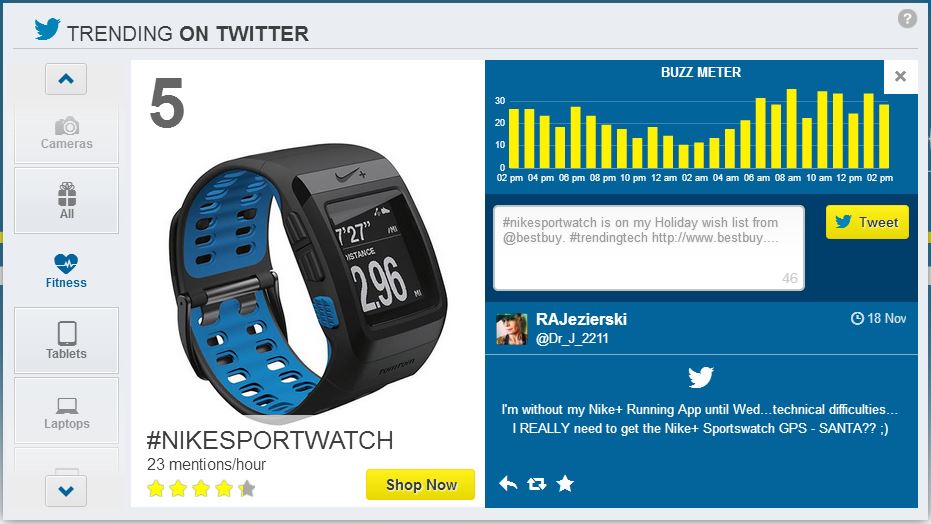In case you missed it, we’ve kicked off our list of retail technology trends you can’t ignore in 2014 and covered Social Commerce and Marketing in our first post. The proliferation of social media, smartphones, tablets, mobile wallets, and wearable technology all made headlines in 2013. These converging technology trends have helped formulate the Age of the Connected Consumer. What impact will the Connected Consumer have on the retail industry in 2014? A profound one.
The empowered consumer has come to expect much more from the brands they interact with in-person and online. What specifically will they demand from retailers in 2014? It’s safe to say that there’s a laundry list of things, but one thing is for sure and that is the retailers will continue to tailor their experience to the individual consumer. Our #2 retail technology trend in 2014 is Personalized Shopping Experiences. While technologies like mobile devices and e-commerce platforms have caused paradigm shifts in delivering personalized shopping experiences, new business models will create revolutionary movements in the industry. Technology will serve as the catalyst for change with retailers, but innovative business models from companies like Amazon and Apple will continue to influence the way consumers engage with brands and shop for goods and services.
![]()
What Will Consumers Expect with Personalized Shopping?
The industry has already seen some of today’s leading retailers’ step up to the challenge with:
Hyper-connectivity and Geotargeting – Apple is an innovator in consumer electronics and continues to push the boundaries when it comes to the customer experience. Apple is taking it to the next level by rolling out iBeacon in its 254 U.S. retail stores for a new personalized shopping experience. Using Bluetooth technology to pinpoint a shopper’s location, Apple can deliver relevant information to the customer via their mobile device. Imagine the impact this in-store technology could have for hypermarket chains like Target or Wal-mart, department stores like Nordstrom and Macy’s, or even personal beauty brands like Sephora. The in-store experience can be personalized using mobile alerts for makeup or beauty product recommendations and mobile offers based on purchasing history and linking the shopper’s Beauty Insider profile to Passbook for loyalty and rewards. (We’ll talk about innovations in clienteling in a bit).
Online Pop-up Shops – Using data analytics to track consumers’ purchasing patterns, social media monitoring and sentiment analysis over the holidays, Best Buy marketed a “Trending Gifts” pop-up store on their website that tracked the top consumer electronics products this holiday season.
Pop-up stores have been a growing trend in the retail industry and Best Buy has not only embraced this at brick-and-mortar locations but has manifested into a pilot project online as well. Best Buy’s e-commerce pop-up concept gave shoppers an exclusive look at the hot consumer electronics items this season in fitness, tablets, cameras, etc. As shoppers browse products, real-time “buzz” on Twitter is displayed and social sharing is encouraged to further engage the consumer. In addition to pulling in unstructured data from Twitter, Best Buy relied on existing internal data sources to show product information and customer ratings.
The challenge for retailers with digital pop-up shops will be speed-to-market. Pop-up shops need to be developed and deployed quickly since they’re often designed for specific marketing campaigns highlighting seasonal shopping trends.
Digital Clienteling –Earlier we talked about apps and automated systems for prompting shoppers with information within the context of a transaction which is often referred to as clienteling. Clienteling uses information about an individual consumer – buying habits and preferences – during interactions within the store to create personalized experiences to strengthen the consumer’s buying relationship with the retailer.
In fashion retailing, Burberry is known worldwide for its high-end retail experience and now investments in digital clienteling are proving to be a key differentiator and sales driver for the brand. Sales associates are armed with iPads using a clienteling app geared to help “accessorize” or virtually make fashion recommendations for a customer. The convergence of physical and digital shopping experiences is quickly becoming the norm in retail technology. Building relationships in the age of the digitally and hyper-connected consumer by exploring tactics like digital clienteling will require building out new digital capabilities and integrating back-end systems.
The Internet of Things – The predictable pathways of information are changing as the physical world fills with sensors making up a new information system. The adoption of the Internet of Things will impact future business models as retailers seek new ways to bring value to customers. The Connected Consumer’s buying preferences will one day be analyzed in real-time at a specific location and dynamic pricing will influence purchasing decisions. Sensors in brick and mortar stores will help gather and process data to optimize retail layouts.
Although it will take time for the Internet of Things to mature, the pace is quickening and executives must begin to think about how the Internet of Things may potentially impact their business and what types of emerging technologies can be deployed now to become an early adopter of a new sensor-driven model that can create value. Putting business processes and advanced technologies in place for opportunities in sensor-driven decision analytics, real-time inventory management, or mobile innovations at the retail point-of-sale (POS), likely to emerge from the Internet of Things, will require increased storage and computing power. Retailers can accomplish this with cloud computing and big data capabilities (both of which we’ll be covering in the next several retail technology trends posts).
Personalization – the Holy Grail of Retailing
Personalization will be the “holy grail” by which retailers live or die by in 2014 and beyond as they seek to serve the hyper-connected consumer. From targeted emails, cross-channel marketing campaigns and web content management systems, to mobile POS and big data in retail, personalization can be achieved in a plethora of ways. Innovative retailers will not only take personalization to a whole new level, but it will transform their future business models and shape retail strategies going forward.

